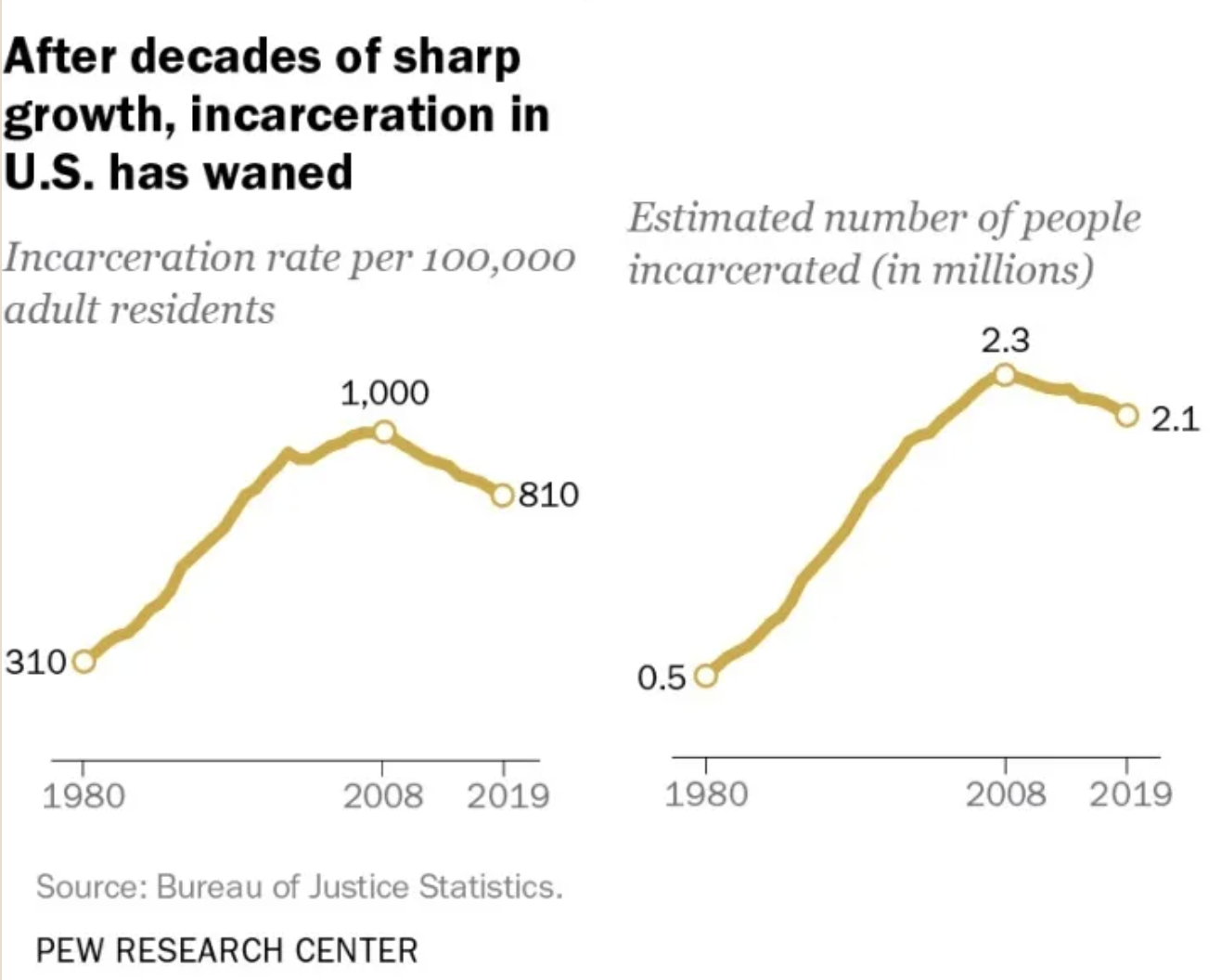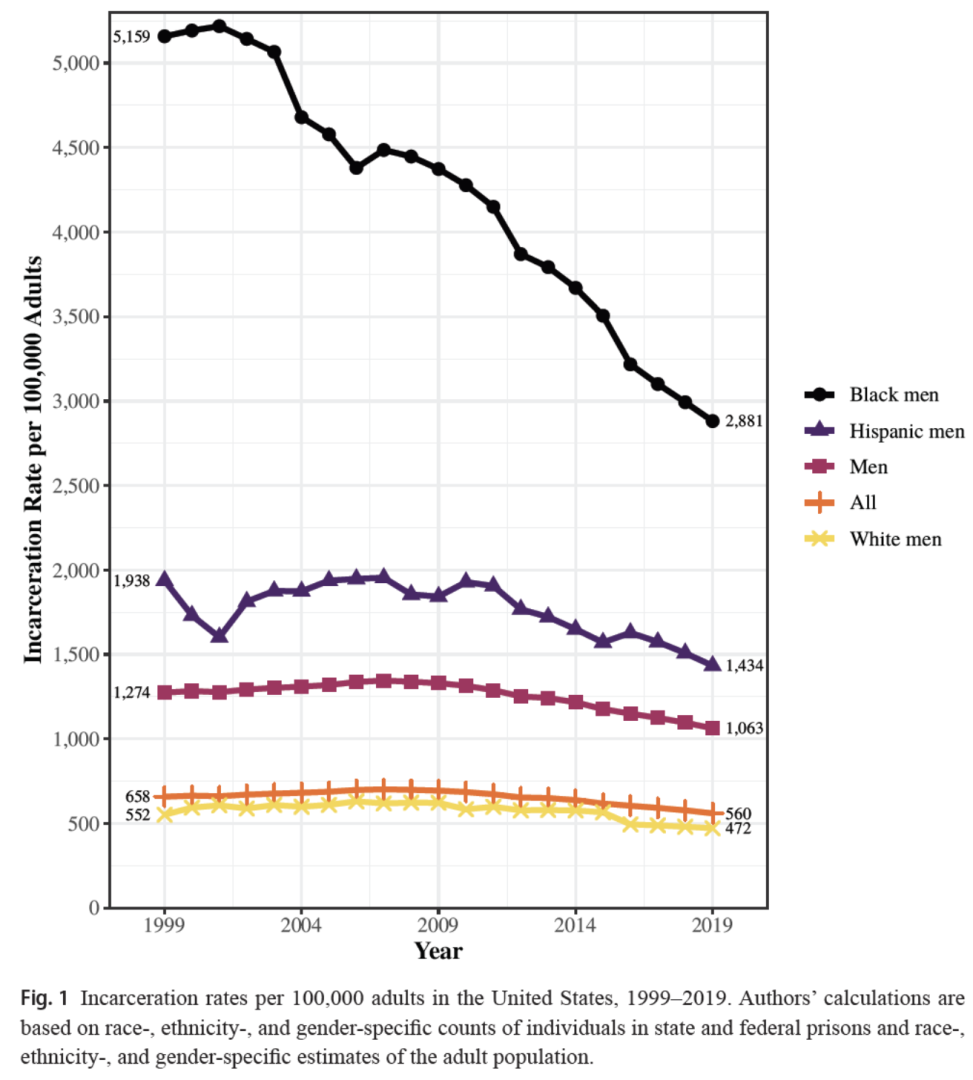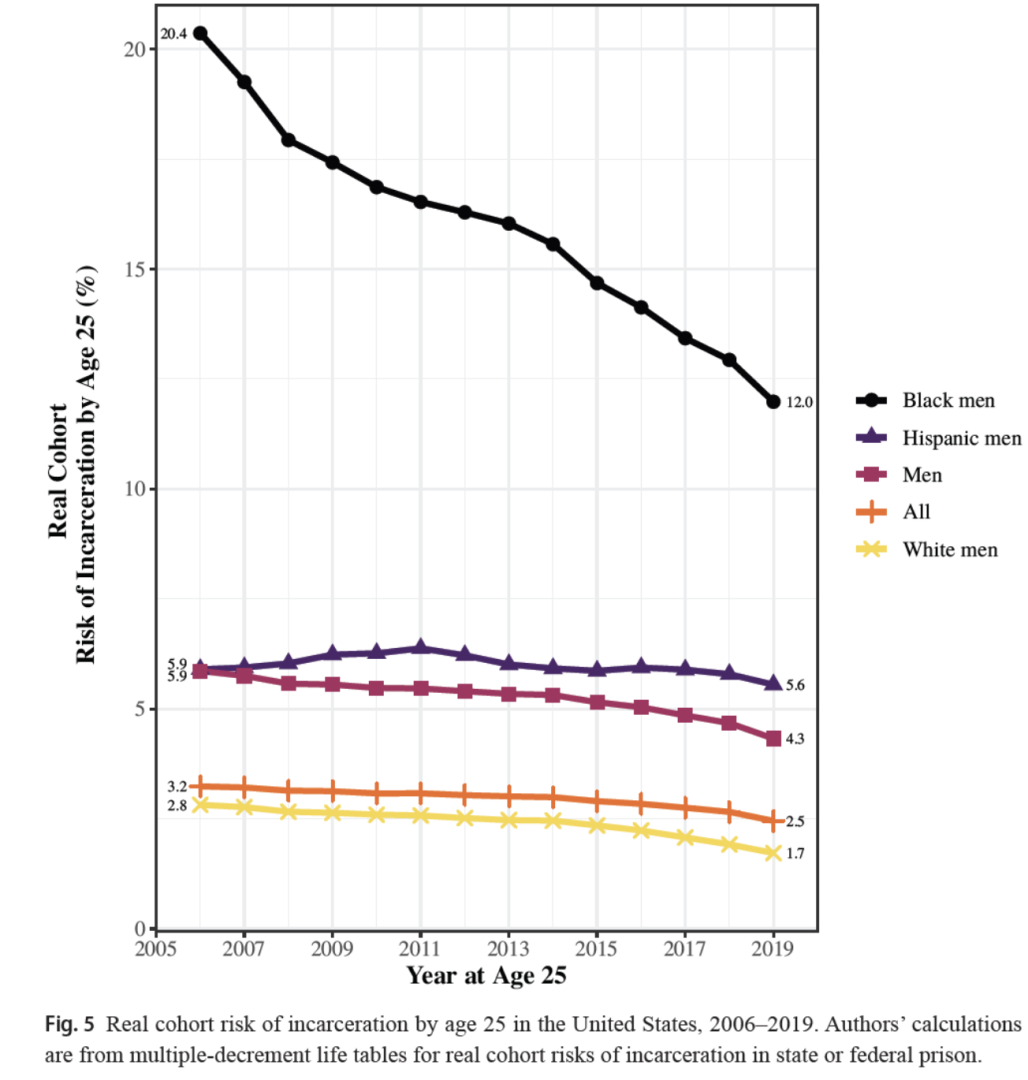Comments
- No comments found

It’s not exactly a secret that US incarceration rates climbed dramatically in the 1990s, but have declined since then.
For example, John Gramlich wrote at the Pew Foundation website a couple of years ago ” America’s incarceration rate falls to lowest level since 1995” (August 16, 2021).

The rate of incarceration among black Americans has fallen as well. Gramlich had written a year earlier “Black imprisonment rate in the U.S. has fallen by a third since 2006” (May 6, 2020). He wrote: “The nation’s imprisonment rate is at its lowest level in more than two decades. The greatest decline has come among black Americans, whose imprisonment rate has decreased 34% since 2006. There were 1,501 black prisoners for every 100,000 black adults at the end of 2018, according to a new report from the Bureau of Justice Statistics (BJS), the statistical agency of the U.S. Justice Department. That was down sharply from 2,261 black inmates per 100,000 black adults at the end of 2006 …”
Incarceration patterns take some time to shift. When many more prison sentences, and sentences of greater length, are given in the 1980s and 1990s, their effect lasts into the 2000s. In particular, prison sentences are more concentrated among young adult men than other demographic groups. The shift toward lower incarceration rates is thus an intergenerational change. Jason P. Robey, Michael Massoglia, and Michael T. Light describe the change in “A Generational Shift: Race and the Declining Lifetime Risk of Imprisonment” (Demography, published online July 12, 2023). From their abstract:
This study makes three primary contributions to a fuller understanding of the contemporary landscape of incarceration in the United States. First, we assess the scope of decarceration. Between 1999 and 2019, the Black male incarceration rate dropped by 44%, and notable declines in Black male imprisonment were evident in all 50 states. Second, our life table analysis demonstrates marked declines in the lifetime risks of incarceration. For Black men, the lifetime risk of incarceration declined by nearly half from 1999 to 2019. We estimate that less than 1 in 5 Black men born in 2001 will be imprisoned, compared with 1 in 3 for the 1981 birth cohort. Third, decarceration has shifted the institutional experiences of young adulthood. In 2009, young Black men were much more likely to experience imprisonment than college graduation. Ten years later, this trend had reversed, with Black men more likely to graduate college than go to prison.
Here’s a figure showing the decline in incarceration rates for men since 1999.

Here’s a figure showing their calculations of the risk of a man being imprisoned by age 25, and how it has evolved over the last couple of decades.

My main point here is just to emphasize the amount of change that has occurred. Whatever one’s views on what the incarceration rates should be, it’s useful to start from a sense of what it in fact is.
For those wanting a more in-depth discussion of the bigger questions of incarceration and crime, one useful starting point might be the article by Magnus Lofstrom and Steven Raphael, “Crime, the Criminal Justice System, and Socioeconomic Inequality” in the Spring 2016 issue of the Journal of Economic Perspectives (30:2, 103-26). They emphasize that black Americans experience both crime and the criminal justice system at higher rates. From the abstract of their paper:
Crime rates in the United States have declined to historical lows since the early 1990s. Prison and jail incarceration rates as well as community correctional populations have increased greatly since the mid-1970s. Both of these developments have disproportionately impacted poor and minority communities. In this paper, we document these trends. We then assess whether the crime declines can be attributed to the massive expansion of the US criminal justice system. We argue that the crime rate is certainly lower as a result of this expansion and in the early 1990s was likely a third lower than what would have been absent changes in sentencing practices in the 1980s. However, there is little evidence that further stiffening of sentences during the 1990s—a period when prison and other correctional populations expanded rapidly—have had an impact. Hence, the growth in criminal justice populations since the 1990s has exacerbated socioeconomic inequality in the United States without generating much benefit in terms of lower crime rates.
Timothy Taylor is an American economist. He is managing editor of the Journal of Economic Perspectives, a quarterly academic journal produced at Macalester College and published by the American Economic Association. Taylor received his Bachelor of Arts degree from Haverford College and a master's degree in economics from Stanford University. At Stanford, he was winner of the award for excellent teaching in a large class (more than 30 students) given by the Associated Students of Stanford University. At Minnesota, he was named a Distinguished Lecturer by the Department of Economics and voted Teacher of the Year by the master's degree students at the Hubert H. Humphrey Institute of Public Affairs. Taylor has been a guest speaker for groups of teachers of high school economics, visiting diplomats from eastern Europe, talk-radio shows, and community groups. From 1989 to 1997, Professor Taylor wrote an economics opinion column for the San Jose Mercury-News. He has published multiple lectures on economics through The Teaching Company. With Rudolph Penner and Isabel Sawhill, he is co-author of Updating America's Social Contract (2000), whose first chapter provided an early radical centrist perspective, "An Agenda for the Radical Middle". Taylor is also the author of The Instant Economist: Everything You Need to Know About How the Economy Works, published by the Penguin Group in 2012. The fourth edition of Taylor's Principles of Economics textbook was published by Textbook Media in 2017.
Leave your comments
Post comment as a guest